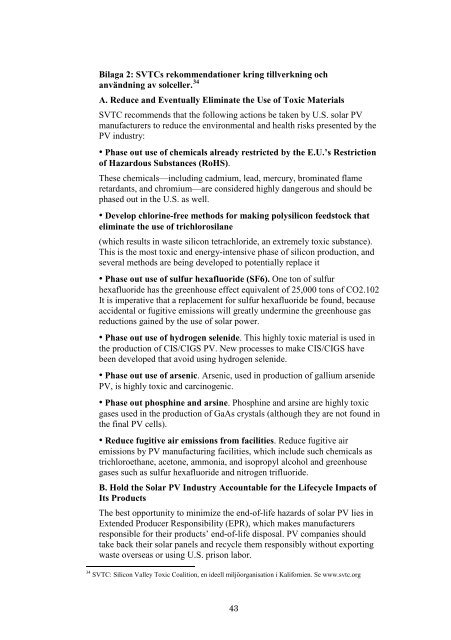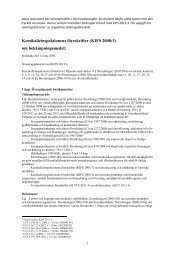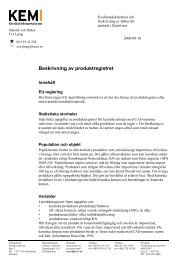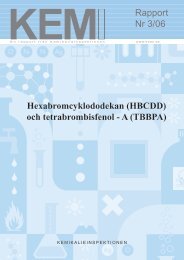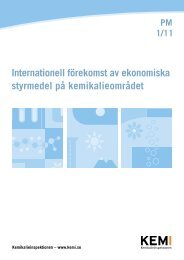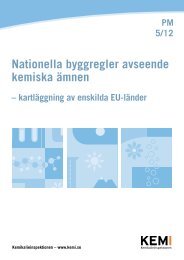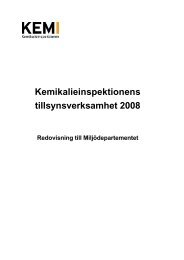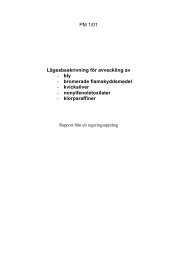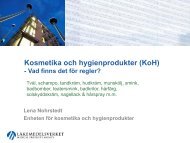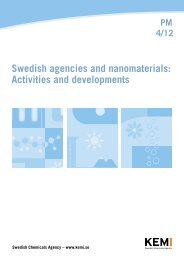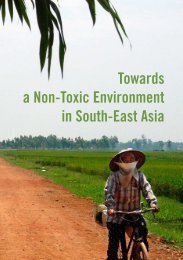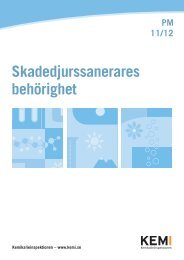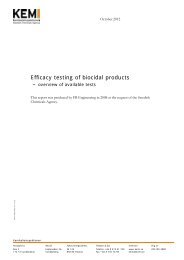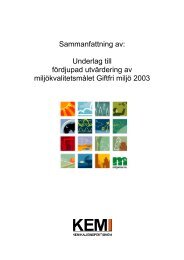Kemikalier och klimat - Kemikalieinspektionen
Kemikalier och klimat - Kemikalieinspektionen
Kemikalier och klimat - Kemikalieinspektionen
You also want an ePaper? Increase the reach of your titles
YUMPU automatically turns print PDFs into web optimized ePapers that Google loves.
Bilaga 2: SVTCs rekommendationer kring tillverkning <strong>och</strong><br />
användning av solceller. 34<br />
A. Reduce and Eventually Eliminate the Use of Toxic Materials<br />
SVTC recommends that the following actions be taken by U.S. solar PV<br />
manufacturers to reduce the environmental and health risks presented by the<br />
PV industry:<br />
• Phase out use of chemicals already restricted by the E.U.’s Restriction<br />
of Hazardous Substances (RoHS).<br />
These chemicals—including cadmium, lead, mercury, brominated flame<br />
retardants, and chromium—are considered highly dangerous and should be<br />
phased out in the U.S. as well.<br />
• Develop chlorine-free methods for making polysilicon feedstock that<br />
eliminate the use of trichlorosilane<br />
(which results in waste silicon tetrachloride, an extremely toxic substance).<br />
This is the most toxic and energy-intensive phase of silicon production, and<br />
several methods are being developed to potentially replace it<br />
• Phase out use of sulfur hexafluoride (SF6). One ton of sulfur<br />
hexafluoride has the greenhouse effect equivalent of 25,000 tons of CO2.102<br />
It is imperative that a replacement for sulfur hexafluoride be found, because<br />
accidental or fugitive emissions will greatly undermine the greenhouse gas<br />
reductions gained by the use of solar power.<br />
• Phase out use of hydrogen selenide. This highly toxic material is used in<br />
the production of CIS/CIGS PV. New processes to make CIS/CIGS have<br />
been developed that avoid using hydrogen selenide.<br />
• Phase out use of arsenic. Arsenic, used in production of gallium arsenide<br />
PV, is highly toxic and carcinogenic.<br />
• Phase out phosphine and arsine. Phosphine and arsine are highly toxic<br />
gases used in the production of GaAs crystals (although they are not found in<br />
the final PV cells).<br />
• Reduce fugitive air emissions from facilities. Reduce fugitive air<br />
emissions by PV manufacturing facilities, which include such chemicals as<br />
trichloroethane, acetone, ammonia, and isopropyl alcohol and greenhouse<br />
gases such as sulfur hexafluoride and nitrogen trifluoride.<br />
B. Hold the Solar PV Industry Accountable for the Lifecycle Impacts of<br />
Its Products<br />
The best opportunity to minimize the end-of-life hazards of solar PV lies in<br />
Extended Producer Responsibility (EPR), which makes manufacturers<br />
responsible for their products’ end-of-life disposal. PV companies should<br />
take back their solar panels and recycle them responsibly without exporting<br />
waste overseas or using U.S. prison labor.<br />
34<br />
SVTC: Silicon Valley Toxic Coalition, en ideell miljöorganisation i Kalifornien. Se www.svtc.org<br />
43


